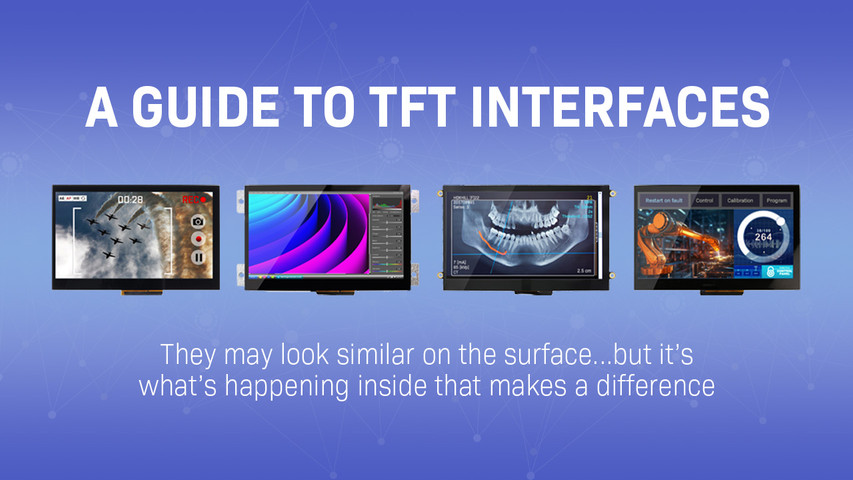OLED vs LCD
If you're designing a display application or deciding what type of TV to get, you'll probably have to choose between an OLED or LCD as your display type. OLEDs and LCDs have different strengths and weaknesses you’ll need to consider when choosing the right one for your particular application.
OLED or LCD: Which Display Is Right For Your Application?
Not sure which one will be best for you? Don’t worry! We’re here to help you figure out the right display for your project or application. In this post we’ll break down the pros and cons of these display types so you can decide which one is right for you.
Related: IPS vs OLED Displays
OLED Vs LCD Displays - What's the Difference?
The difference between LCDs and OLEDs are how the images are produced. LCDs utilize liquid crystals that produce an image when light is passed through the display. OLED displays generate images by applying electricity to organic materials inside the display.
OLED and LCD Main Difference:
On an LCD, the pixels are illuminated by a backlight. On an OLED, there is no backlight; each pixel gets its own illumination.
These different technological approaches to display technology have big impact in some features including contrast, brightness, viewing angles, lifespan, black levels, image burn-in, and price.
What are the main differences between OLEDs and LCDs?
- Contrast
- Brightness
- Viewing angles
- Lifespan
- Black levels
- Burn-in
- Price
Related: Understanding Viewing Angles
Things to consider before choosing an OLED or an LCD
Everything from the environment your display will be used in, your budget, to the lighting conditions and the required durability will play a part in this decision.
You’ll need to weigh the pros and cons of each display type to determine which one is right for your application.
Contrast
Contrast refers to the difference between the lightest and darkest parts of an image. High contrast will produce sharper images and more easily readable text. It’s a crucial quality for high fidelity graphics and images or to make sure that a message on a display is very visible.
By design, most LCDs will have a built-in backlight to make their graphics and images visible. This is the reason you’re still able to see light coming through on images that are meant to be dark on an LCD monitor, display, or television.
OLEDs by comparison, deliver a drastically higher contrast by dynamically managing their individual pixels. When an image on an OLED display uses the color black, the pixel shuts off completely and renders a much higher contrast than that of LCDs.
OLED vs LCD - Who is better at contrast?
For the boldest, sharpest images with high contrast, OLED is better.
Related: IPS vs OLED
Brightness
One of the primary differences between OLEDs and LCDs is that LCDs contain an LED backlight, and OLEDs do not. In terms of individual pixel brightness, OLED displays tend to have an advantage because each pixel illuminates individually. This means OLEDs can have more intense brightness at the pixel level, as they are not relying on a separate backlight source. However, if we consider the overall brightness of the entire screen, LCDs often win. This is because LCDs use a constant backlight that illuminates the entire display area, creating an overall brighter image. This also means that LCDs can have more 'wasted' light, as the backlight is always lighting up the whole display, even if only a few pixels need to be lit.
In summary, whether an LCD or an OLED display is brighter can depend on whether you're looking at the brightness of individual pixels or the brightness of the entire screen. In general, OLEDs may have brighter individual pixels, while LCDs can offer a brighter overall display.
OLEDs are self-illuminating, so they have no backlight. This means LCDs are able to produce brighter images due to their powerful backlights.
Video: Comparing a standard TFT LCD vs an IPS TFT LCD in direct sunlight.
Having a high brightness level is important if your display is going to be used in direct sunlight or somewhere with high ambient brightness. The display's brightness level isn't as important if it’s going to be used indoors or in a low light setting.
OLED vs LCD - Who is better at Brightness?
For a display that can remain visible in bright conditions and even direct sunlight, LCDs are the best solution.
Viewing Angles
Have you ever looked at a screen from an angle and noticed that the images became washed out or shadowy? The further away you get from the “front and center” view, the worse the image appears to be. This is an example of viewing angles in action – the wider the viewing angle, the better the images on screen will appear as you view them from different vantage points.
Having a wide viewing angle is important for displays that you don’t always view straight on. Wide viewing angles allow the images on screen to stay consistent and retain their quality no matter where the viewer is looking at them from.
Like we mentioned in the previous section, OLED displays have no backlight. This means the display is much thinner than LCD displays and their pixels are much closer to the surface of the display, giving them an inherently wider viewing angle.
Images on OLED displays maintain their quality and readability from nearly any angle. The most common type of LCDs don’t.
You’ll often notice images becoming distorted or losing their colors when tilting an LCD or when you view it from different angles. However, many LCDs now include technology to compensate for this – specifically In-Plane Switching (IPS).
LCDs with IPS are significantly brighter than standard LCDs and offer viewing angles that are on-par with OLEDs.
OLED vs LCD - Who is better at Viewing Angles?
In the case of viewing angles, more modern LCDs are able to compete with OLEDS. But when it comes to the standard version of these display types OLEDs offer the best viewing angles.
Lifespan
LCDs have been on the market much longer than OLEDs, so there is more data to support their longevity. On average LCDs have proven to perform for around 60,000 hours (2,500) days of operation.
With most LCDs you can expect about 7 years of consistent performance. Some dimming of the backlight has been observed but it is not significant to the quality of the display.
OLEDs are a newer technology in the display market, which makes them harder to fully review. Not only does OLED technology continue to improve at a rapid pace, but there also hasn’t been enough time to thoroughly observe their performance.
Current day OLEDs are projected to perform consistently for 100,000 hours when properly maintained. That’s 10 hours a day for 10 years.
You must also consider OLED’s vulnerability to image burn-in. The organic material in these displays can leave a permanent afterimage on the display if a static image is displayed for too long.
So depending on how your OLED is used, this can greatly affect its lifespan. An OLED being used to show static images for long periods of time will not have the same longevity as one displaying dynamic, constantly moving images.
OLED vs LCD - Which one last longer?
There is not yet a clear winner when it comes to lifespans between LCD and OLED displays. Each have their advantages depending on their use-cases. It’s a tie!
OLED vs LCD - Feature Comparison Table
| OLED | LCD | |
| Contrast | Best | Good |
| Brightness | Good | Best |
| Viewing angle | Best | Good |
| Black level | Best | Good |
| Resolution | Best | Best |
| Refresh rate | Best | Best |
| Energy consumption | Best | Best |
| Lifespan | Best | Best |
| Burn-in | Good | Best |
| Price | Good | Best |
OLED Vs LCD Display: Which One To Choose?
There’s a lot to consider when deciding on a display type for your application, so we hope this guide made the choice easier for you.
Use LCDs For:
We recommend LCDs for larger display applications and projects that require the most cost-effective solution.
Use OLEDs For:
For a display application requiring the best colors, contrast, and viewing angles – especially for small and lightweight wearable devices – we would suggest an OLED display.
Still have questions? Connect with us via our support center to talk to one of our experts. We’re always here to help.
Latest Blog Posts
-
A Guide to TFT Display Interfaces
Display interfaces often get less attention than screen resolution or brightness, but they carry jus …Dec 16th 2025 -
Choosing the Right Display Resolution: A User-Friendly Guide
Display resolution is one of the most defining choices in product interface design. It determines ho …Dec 11th 2025 -
Arduino vs Raspberry Pi vs BeagleBone: Key Features and Differences
If you're working on an electronics project—whether it's for a DIY automated device, a digital sign, …Dec 8th 2025





